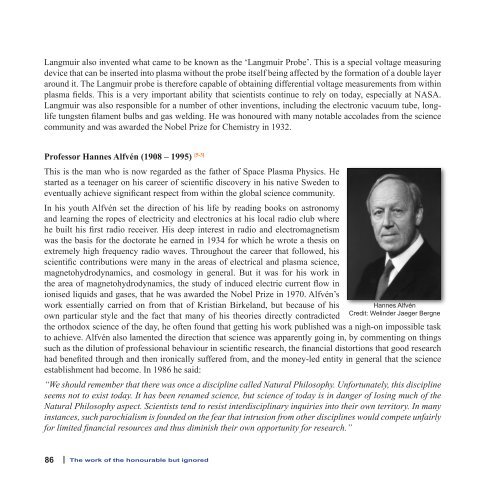A Beginner's View of Our Electric Universe - New
A Beginner's View of Our Electric Universe - New
A Beginner's View of Our Electric Universe - New
Create successful ePaper yourself
Turn your PDF publications into a flip-book with our unique Google optimized e-Paper software.
Langmuir also invented what came to be known as the ‘Langmuir Probe’. This is a special voltage measuring<br />
device that can be inserted into plasma without the probe itself being affected by the formation <strong>of</strong> a double layer<br />
around it. The Langmuir probe is therefore capable <strong>of</strong> obtaining differential voltage measurements from within<br />
plasma fields. This is a very important ability that scientists continue to rely on today, especially at NASA.<br />
Langmuir was also responsible for a number <strong>of</strong> other inventions, including the electronic vacuum tube, longlife<br />
tungsten filament bulbs and gas welding. He was honoured with many notable accolades from the science<br />
community and was awarded the Nobel Prize for Chemistry in 1932.<br />
Pr<strong>of</strong>essor Hannes Alfvén (1908 – 1995) [5-3]<br />
This is the man who is now regarded as the father <strong>of</strong> Space Plasma Physics. He<br />
started as a teenager on his career <strong>of</strong> scientific discovery in his native Sweden to<br />
eventually achieve significant respect from within the global science community.<br />
In his youth Alfvén set the direction <strong>of</strong> his life by reading books on astronomy<br />
and learning the ropes <strong>of</strong> electricity and electronics at his local radio club where<br />
he built his first radio receiver. His deep interest in radio and electromagnetism<br />
was the basis for the doctorate he earned in 1934 for which he wrote a thesis on<br />
extremely high frequency radio waves. Throughout the career that followed, his<br />
scientific contributions were many in the areas <strong>of</strong> electrical and plasma science,<br />
magnetohydrodynamics, and cosmology in general. But it was for his work in<br />
the area <strong>of</strong> magnetohydrodynamics, the study <strong>of</strong> induced electric current flow in<br />
ionised liquids and gases, that he was awarded the Nobel Prize in 1970. Alfvén’s<br />
work essentially carried on from that <strong>of</strong> Kristian Birkeland, but because <strong>of</strong> his<br />
own particular style and the fact that many <strong>of</strong> his theories directly contradicted<br />
the orthodox science <strong>of</strong> the day, he <strong>of</strong>ten found that getting his work published was a nigh-on impossible task<br />
to achieve. Alfvén also lamented the direction that science was apparently going in, by commenting on things<br />
such as the dilution <strong>of</strong> pr<strong>of</strong>essional behaviour in scientific research, the financial distortions that good research<br />
had benefited through and then ironically suffered from, and the money-led entity in general that the science<br />
establishment had become. In 1986 he said:<br />
“We should remember that there was once a discipline called Natural Philosophy. Unfortunately, this discipline<br />
seems not to exist today. It has been renamed science, but science <strong>of</strong> today is in danger <strong>of</strong> losing much <strong>of</strong> the<br />
Natural Philosophy aspect. Scientists tend to resist interdisciplinary inquiries into their own territory. In many<br />
instances, such parochialism is founded on the fear that intrusion from other disciplines would compete unfairly<br />
for limited financial resources and thus diminish their own opportunity for research.”<br />
6 | The work <strong>of</strong> the honourable but ignored<br />
Hannes Alfvén<br />
Credit: Welinder Jaeger Bergne


